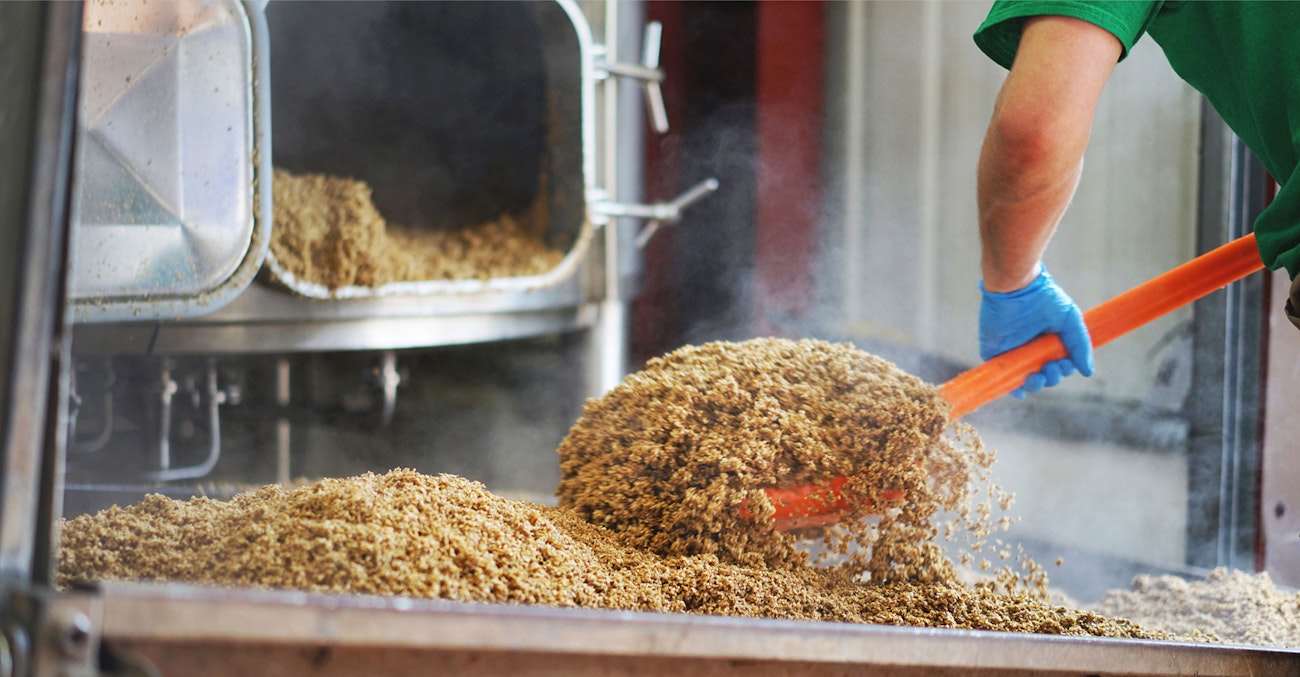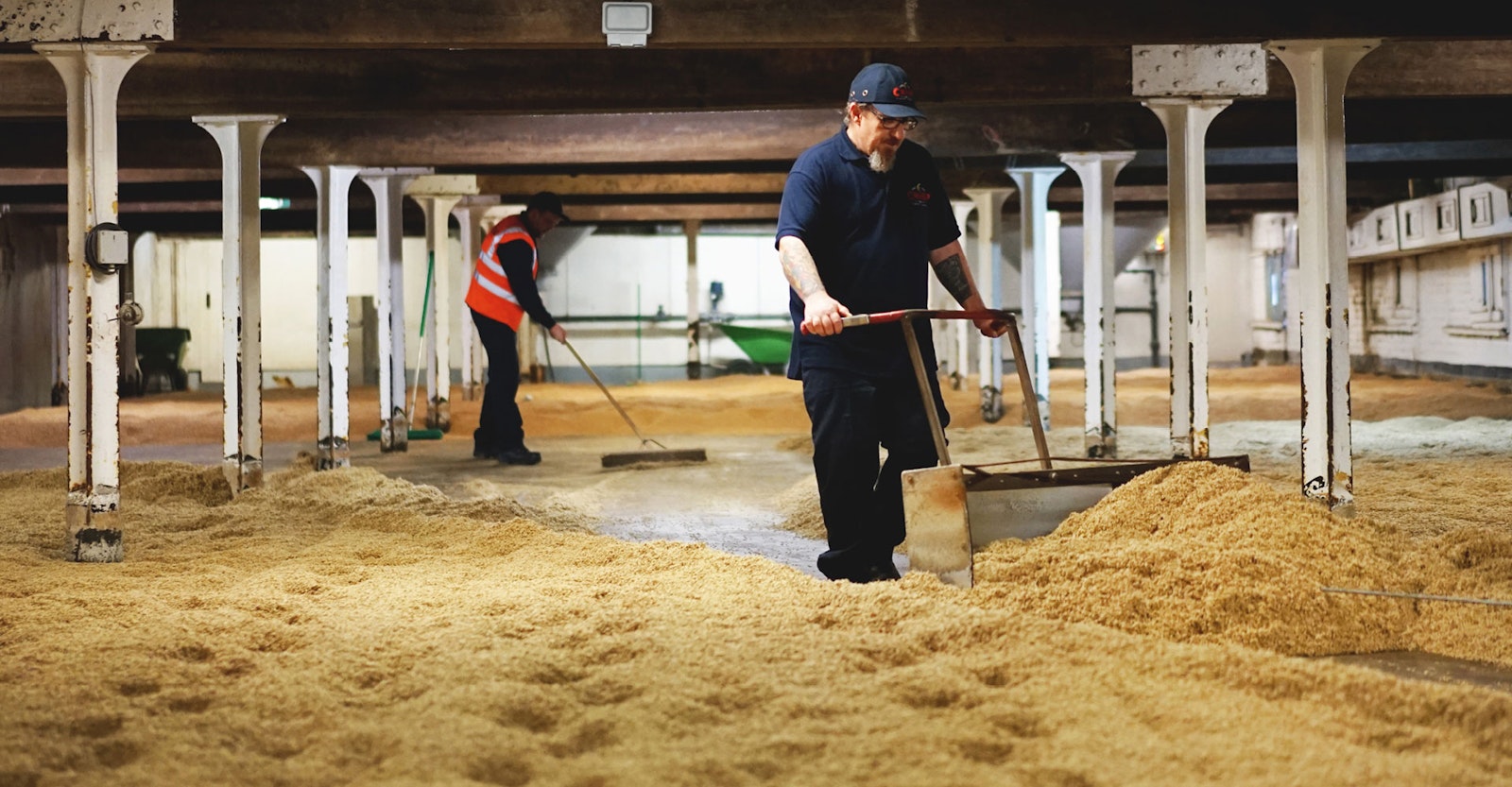Pitch-black in color and topped with a dense, tan-hued head of foam, unctuous in the way it glides around the inside of your glass when poured, RedWillow Brewery’s Double Heritage Porter has the uncanny ability to capture your imagination before you’ve even taken a sip—but once you do, you’re smitten.
This 8.8 percent ABV beer is resolutely old-school in flavor—no surprise, since it’s based on recipes from the 19th century. Eschewing the sweeter chocolate- or caramel-led character of many contemporary porters, Double Heritage instead focuses on the interplay among dark roast coffee, bitter cacao, and a touch of molasses. A slight astringency dries up the finish and invites you back for another taste. Dispensed from cask via beer engine, this big porter excels—its gentle carbonation and cellar-cool serving temperature allow its depth to shine.
“It’s very malt-centric,” say RedWillow founder and head brewer Toby McKenzie. “It uses a complex base of five different grains, and one shot of Goldings at the top of the boil.”
That grist includes small portions of amber, black, brown, and chocolate malts—each about 5 percent of the bill. The most significant twist, however, is that McKenzie replaces 20 percent of the pale base with malt made from a specialty heritage barley variety known as Chevallier, produced by Crisp Malt of Great Ryburgh, Norfolk, in the east of England.
A two-row, narrow-eared variety, Chevallier dominated barley farming in England throughout the 19th and early 20th centuries, beginning to fall out of favor about 1920. By 1940, production of Chevallier had ceased. In 2017, however—after four years of small-batch trials—Crisp commercially released a five-ton batch produced at its traditional floor maltings at its headquarters in the east of England.
At RedWillow, McKenzie was one of the first brewers to get to play with it.
On its own, Chevallier can be “dominant,” he says. “It has a pronounced grainy flavor and texture. But once you start blending it with other varieties, it shines and really helps to round out a beer nicely.”
Over time, Chevallier has become an ingredient that McKenzie returns to often, using it in beers such as RedWillow Dark Mild, the aforementioned Double Porter, and, most recently, one called Very English IPA.
In initial batches of that IPA, McKenzie experimented by using 90 percent Chevallier pale malt in the grist. But he found that the flavor—which he describes as a “nutty, toasty, roastiness”—was a touch overwhelming. More recent iterations have dialed its inclusion back to around 60 percent, balancing the Chevallier with some more typical base malts. That’s still a large percentage of the grist, however.
“The efficiency is definitely lower, and we know to a single decimal point the efficiency of our kit,” McKenzie says. “With Chevallier, we’re getting about 10 to 15 percent less extract, so we need to use more of it.”
Founded in 2010 by husband and wife Toby and Caroline McKenzie, RedWillow is based in Macclesfield, Cheshire, less than 20 miles south of Manchester city center in England’s northwest. It’s fair to say that they’re obsessed with flavor, and it’s that obsession that’s led Toby to brewing with heritage barley malt varieties.
Another variety he’s had the opportunity to try is Haná, also produced by Crisp. Taking its name from the Haná Valley in the Czech region of Moravia, this landrace variety is possibly the most important ancestor to all today’s pale two-row varieties. While farmers in the Haná valley still grow malting barley, those are varieties that have gradually replaced the original Haná barley that grew in the 19th century—and, famously, went into Josef Groll’s original pilsner beer.
Appropriately, McKenzie used Haná to make lagers. He describes them as “ultra, ultra pale”—in part because the malt is relatively less modified, resulting in lower levels of extract during mashing. Despite this, the flavor is distinctive, with subtle nutty, grainy undertones you might not expect from a typical pilsner malt.

Fields of Gold
British farmers have been cultivating heritage barleys for brewers for decades. You have undoubtedly heard about two of the most popular ones: Maris Otter and Golden Promise. Such is the popularity of these malts that they have remained in production for more than 50 years—bucking a trend of barley varieties that often last only five to seven years, retired in favor of more efficient, higher-yield crops.
And if you ask a brewer why they are so reliant on Maris Otter or Golden Promise, the answer is usually simple: flavor.
In parallel to the 11,000-plus breweries that have emerged in North America over the past few decades, there are now almost 2,000 in the United Kingdom. As brewers look to diversify their offerings, the malt suppliers and larger producers such as Crisp turn to even older heritage grains to find some of that variety.
Besides Chevallier, Haná, and Maris Otter, that includes another resurrected variety called Plumage Archer—a hybrid first developed at Warminster Maltings in 1905. Plumage Archer, in fact, is a grandparent of Maris Otter, which wasn’t bred until 1965.

Left:Toby McKenzie of RedWillow samples a beer in the cellar.Right: Double Heritage Porter poured from the side-pull faucet.
“Both Chevallier and Haná bring flavor into beers that aren’t provided by modern malting barley varieties,” says Dave Griggs, technical director at Crisp. “This is also true for Maris Otter, which continues to contribute to the success of a range of award-winning beers.”
Chevallier barley reappeared in 2013, developed by Chris Ridout at the John Innes Centre in Norwich. (The center reportedly holds seedstock of about 10,000 barley varieties.) Crisp soon began malting the barley, releasing it as a trial about seven years ago. Today, it’s readily available to brewers in Britain and farther afield.
Part of Crisp’s Heritage Malts series, Chevallier costs a bit more than standard malt—as do Haná, Maris Otter, and Plumage Archer. However, Griggs makes the case that Chevallier excels in certain recipes, especially in traditional milds, porters, and English-style IPAs.
He also explains that integrating these malts into recipes isn’t quite as simple as substituting them into your usual malt bill. Brewers, Griggs says, “need to be aware that these heritage malts need to be handled a little differently in the brewhouse, such as a longer mash stand time for Chevallier and step mashing for Haná. But these requirements just reflect how malt from these heritage barleys would have been handled back in their heyday.”

Graining out
A Link to the Past
Crisp isn’t the only British maltster investing in the revival of heritage varieties. Based in Fife, in the east of Scotland, Crafty Maltsters is a family-owned, farm-based maltster working with heritage Scottish varieties such as Annat and Bere.
The latter is an ancient six-row barley variety originally cultivated on the Hebrides islands, including Orkney and Berneray, supposedly for many thousands of years. (Bere also was used in a historical re-creation of Dublin Castle Ale—see page 76 in our Spring 2024 issue.) Crafty Maltsters was able to secure a small amount of seedstock in 2021, allowing a handful of brewers to brew with it, including Gareth Young of Epochal Barrel Fermented Ales in Glasgow.
“It’s an important way of connecting to our agricultural and brewing heritage and of communicating that heritage to consumers,” Young says. “Bere is the oldest cereal in the U.K., probably grown here since the Neolithic period, so its flavors have been part of our brewing and distilling culture for more or less as long as we’ve been practicing those arts.”
Young used the variety to brew Hesperus, a 7.2 percent ABV Scottish stock ale that also features whole-cone Goldings and Hallertau Blanc. The result is powerfully flavored, combining rich, earthy-yet-sweet notes with a delicate, leafy, floral, almost wine-like character and a nuanced acidity. It’s as enjoyable to drink on its own as it is with a plate of cheese—or with that most traditional of Scottish dishes: haggis, neeps, and tatties. “It’s a very dry, bitter beer, and the character of that barley is an important part of the beer’s balance,” Young says.
In Edinburgh, Scotland, Newbarns Brewery could have used these heritage malts in traditional ales, but instead they’ve been brewing a series of single-malt lagers. The results are astounding. While the base recipes are pretty much the same—with the same timings and methods applied throughout—each lager has a distinctive character of its own. The Plumage Archer lager, for example, is slightly darker in color, with a hazelnut-like character; the Annat lager is paler, showcasing floral notes combined with fresh green-apple peel.
“We’ve brewed many different styles of beer with heritage varieties, but we always start with a simple lager recipe to get to know the subtleties of the variety,” says Newbarns cofounder Gordon McKenzie. “There’s a real elegance with some varieties that means we can achieve some things with super-simple recipes because the barley does the heavy lifting. On the other hand, Bere and Chevallier can be really quite intense, so we don’t use them often in pale lagers any longer.”
Other brewers have found similar challenges in working with these varieties. Beak Brewery, based in the town of Lewes, Sussex, experimented with some Bere sourced from a farm in Oxfordshire. This “regeneratively farmed” barley also was subject to multiple-cropping, meaning it was farmed with a selection of other grains, including wheat, oats, and rye—all harvested together, before being malted at Crisp. The idea is to do a less intensive method of farming, helping to keep carbon dioxide in the soil and reduce beer’s carbon footprint. Beak used the variety in a batch of Bampa, its annually released best bitter.
“It smelled amazing on the brew day, but unfortunately it was just too overpowering in the final beer,” says Daniel Tapper, Beak’s owner. “It tasted more like a Belgian dark beer than a best and so was put down the drain.”
Undeterred, Tapper and head brewer Robin Head-Fourman went back to the recipe, this time dialing back on the Bere—not unlike what McKenzie at RedWillow did with the Chevallier in his Very English IPA. Tapper describes the resulting beer as “marvelous,” showcasing flavors that include honeycomb toffee, black pepper, rye bread, and even an earthy, silage-like note.
I tasted the beer myself; it has a far more pronounced character than you might expect from a traditional English bitter, but it’s one that’s as delicious as it is compelling. Sadly, with the supply of Bere still thin on the ground, it might be some time before Beak gets to brew it again.
“Unfortunately, the heritage-malt version of Bampa has been put on hold for now, as we only had one crop to work with,” Tapper says. “I’d really like to work with heritage grain more in the future, not only because of its unique character, but also because it inspires non-hop-oriented conversations, which are somewhat of a rarity these days.”

